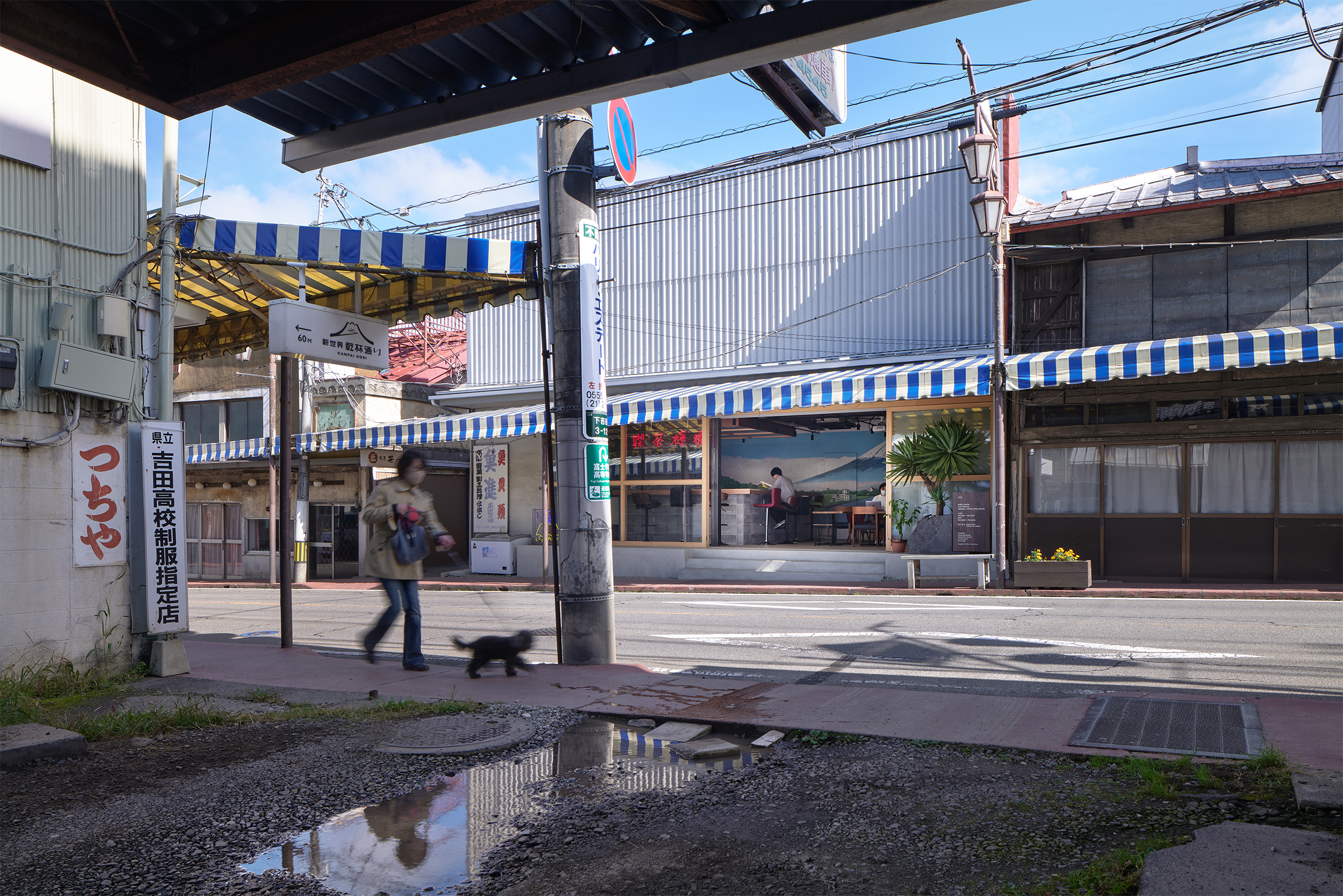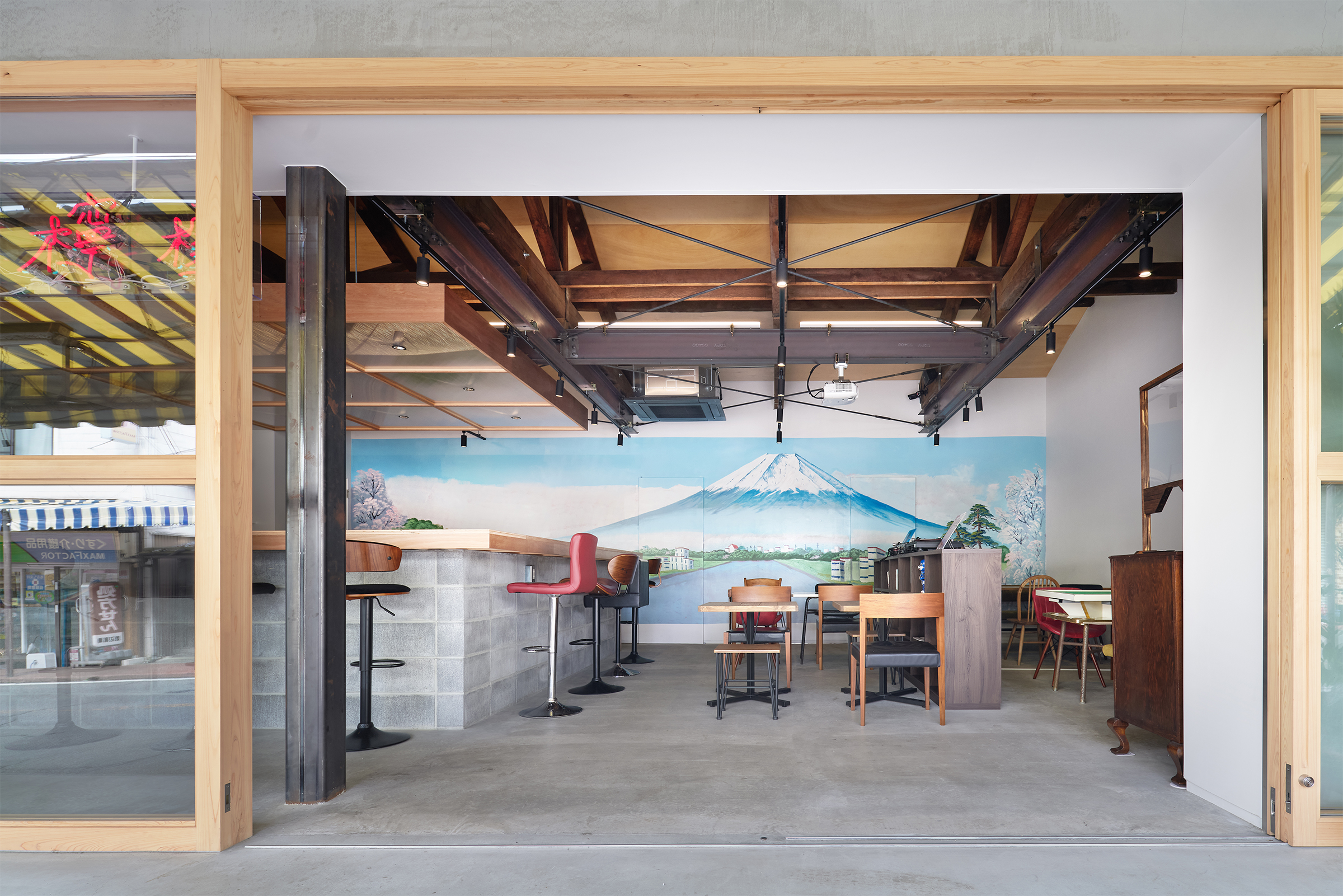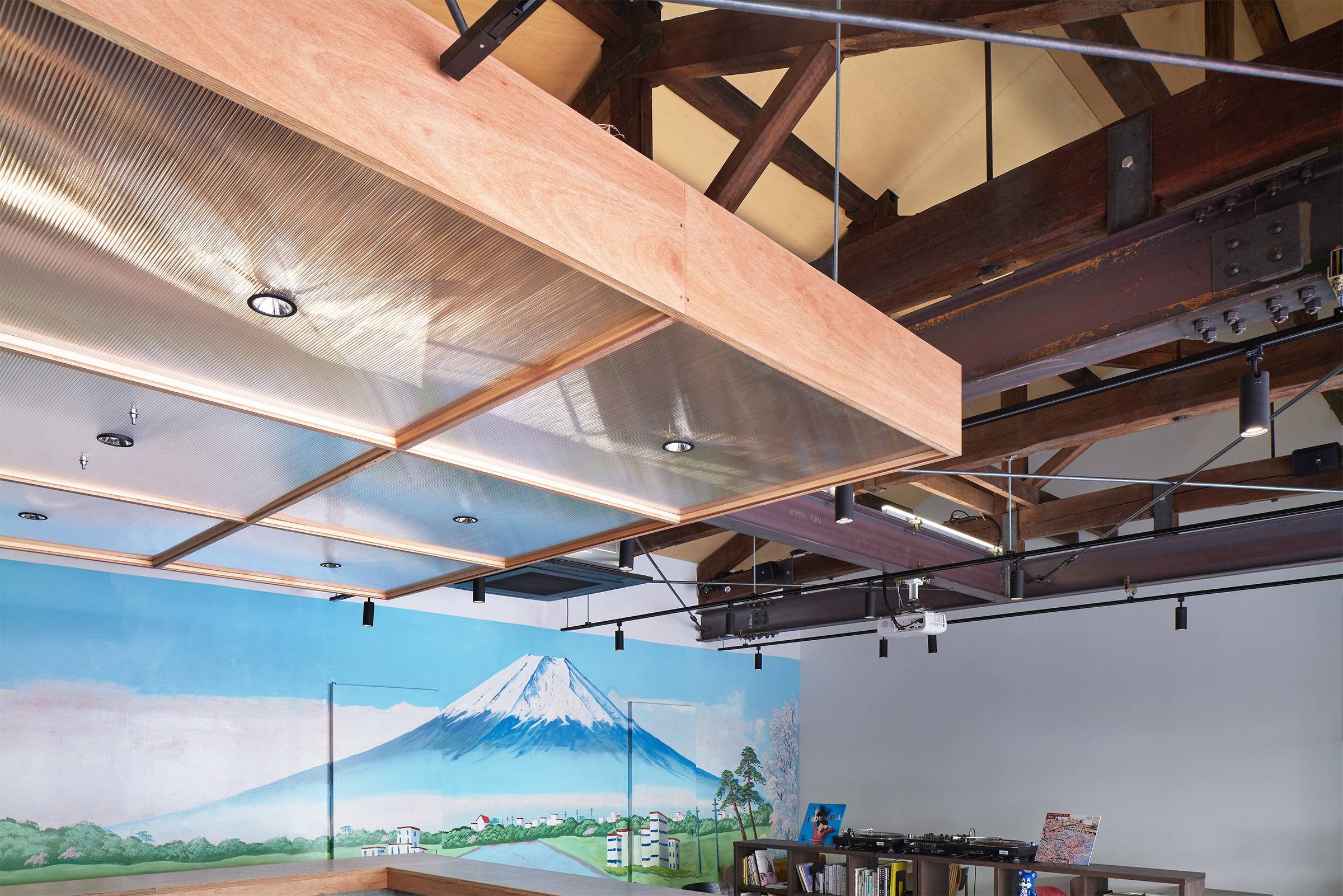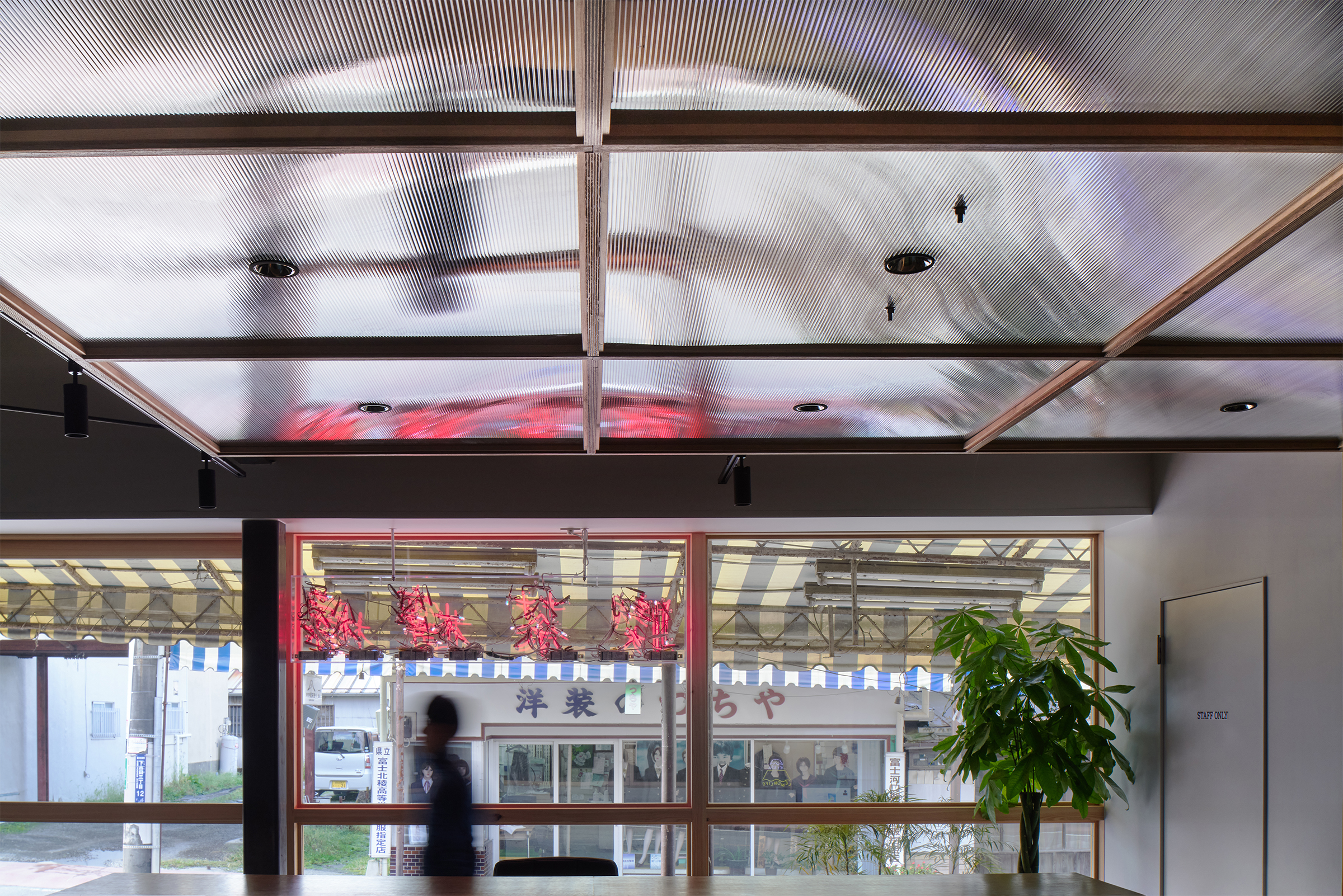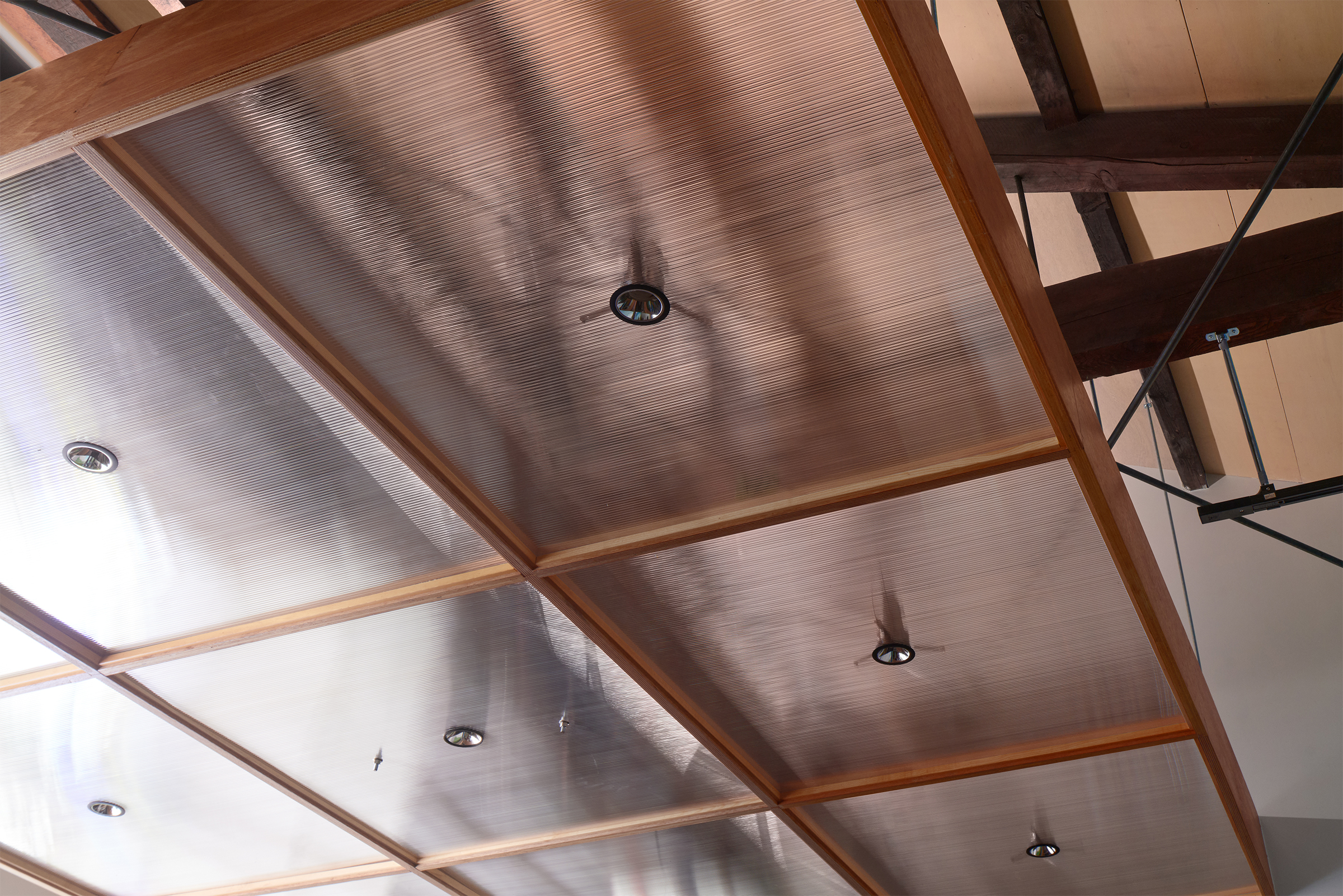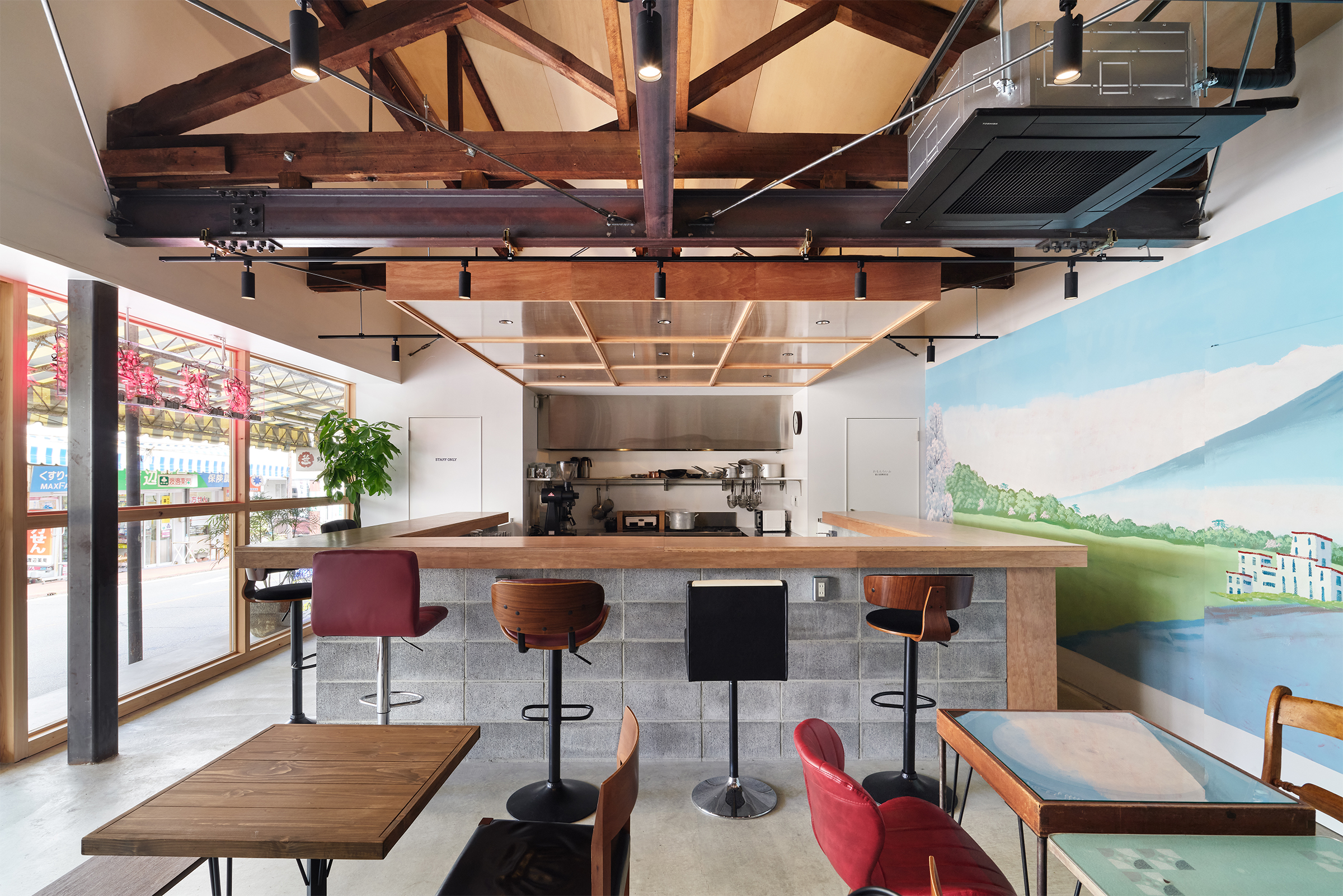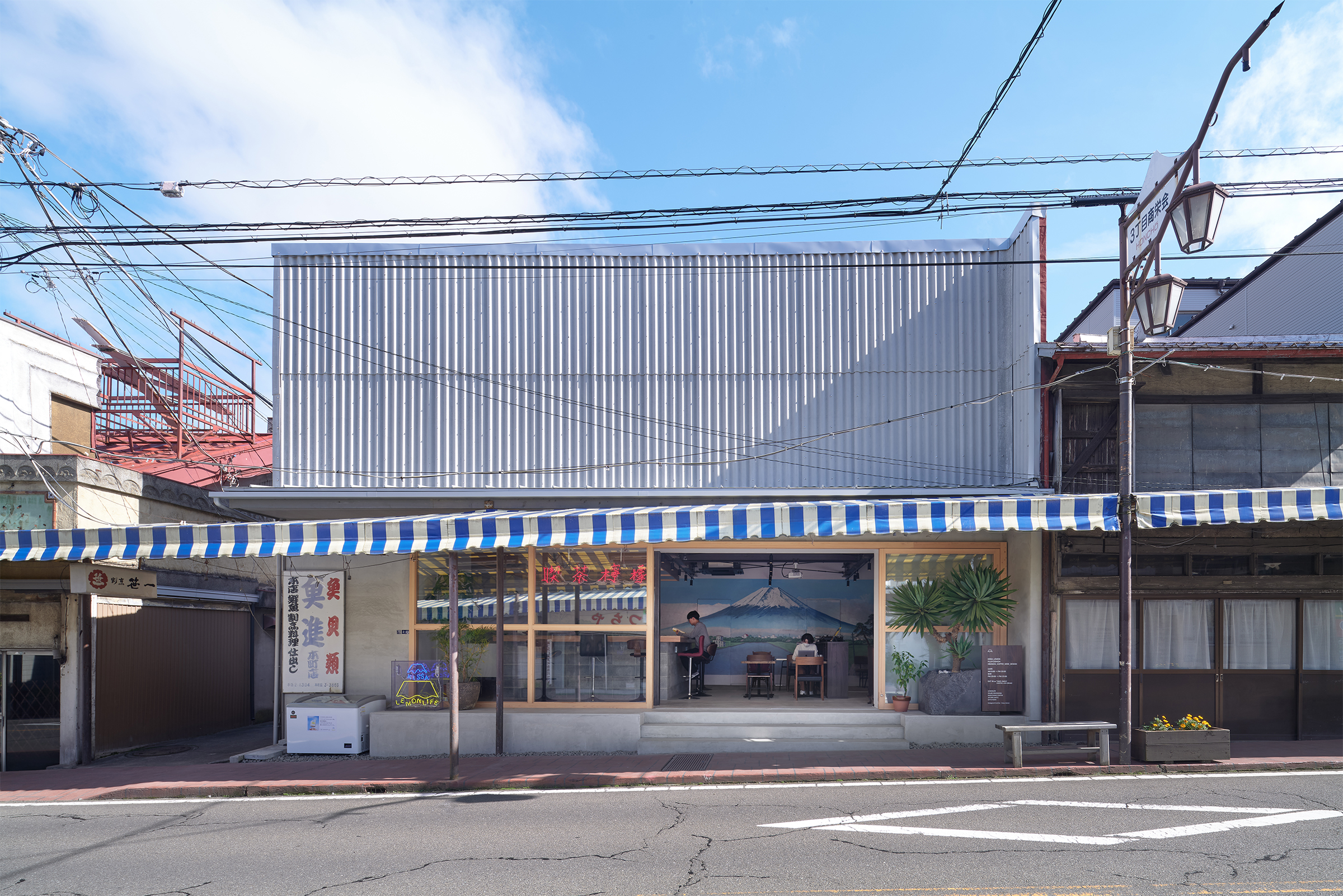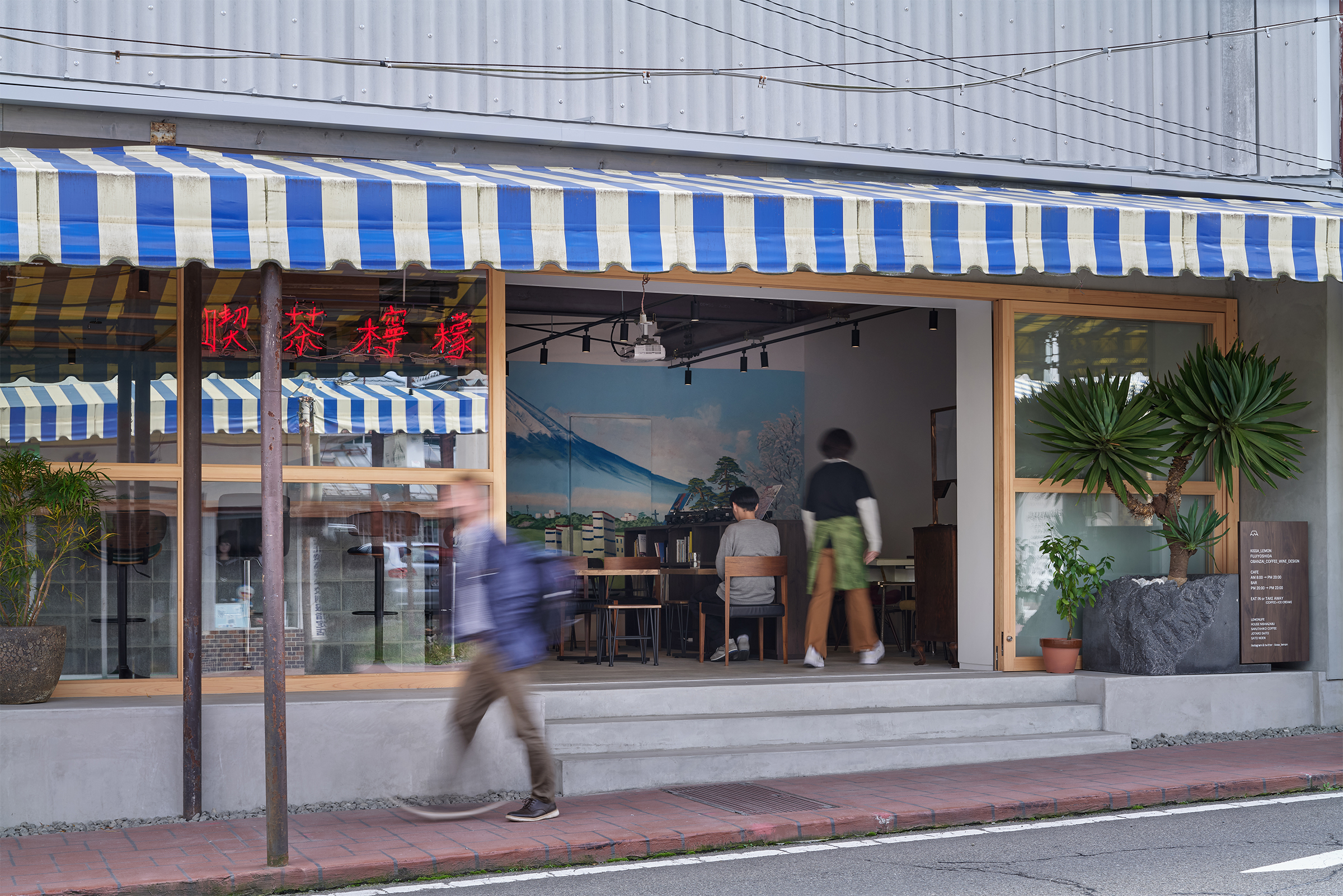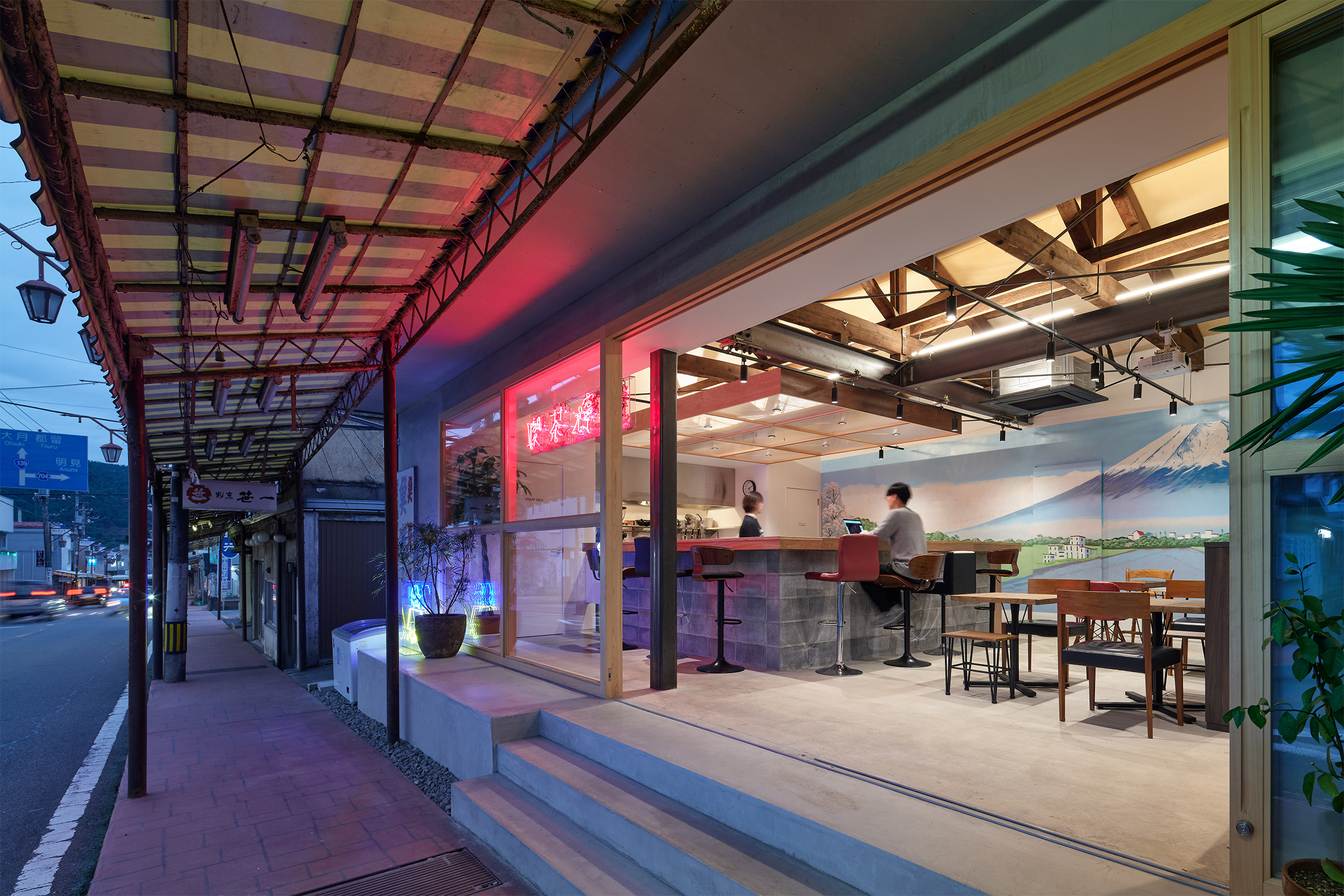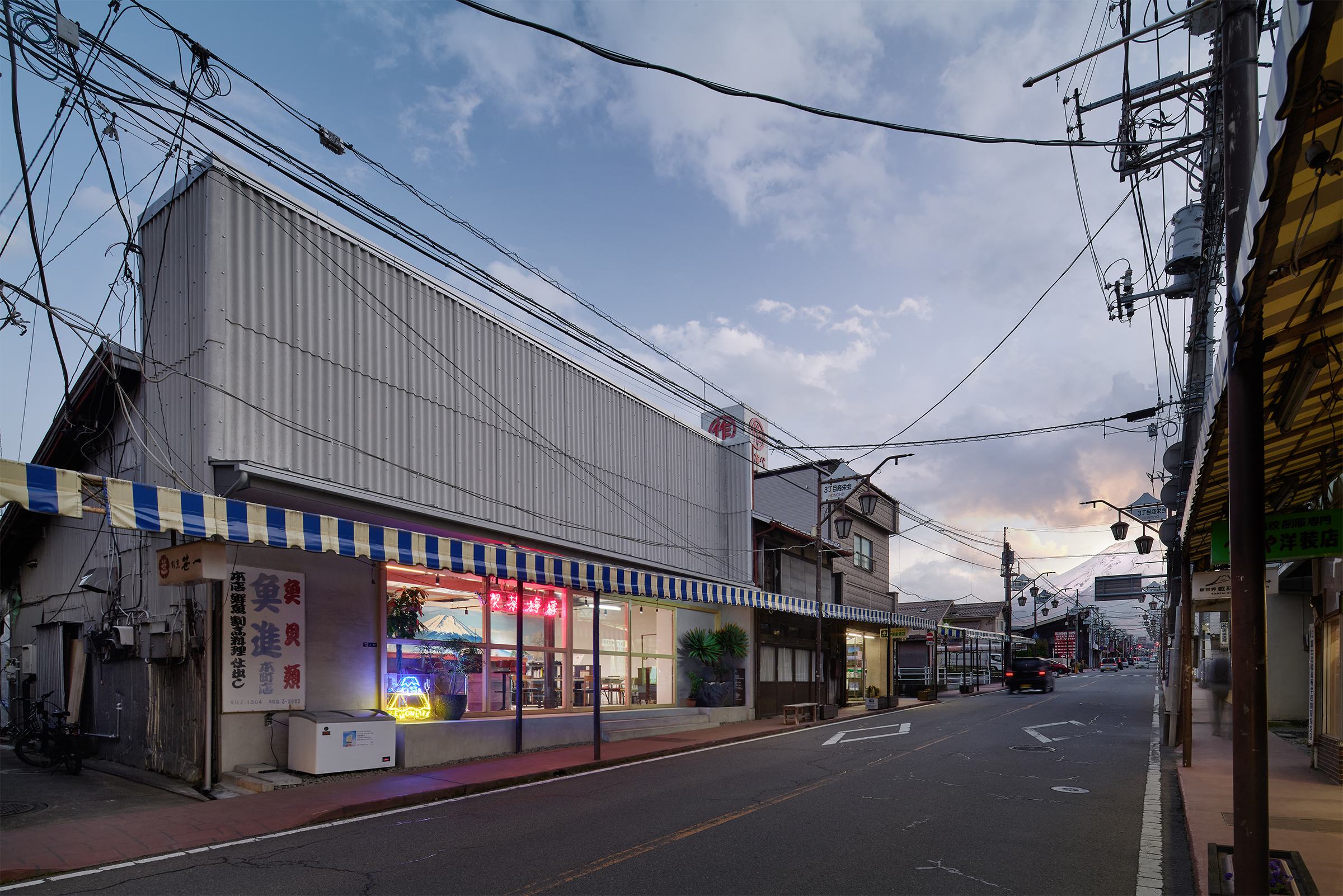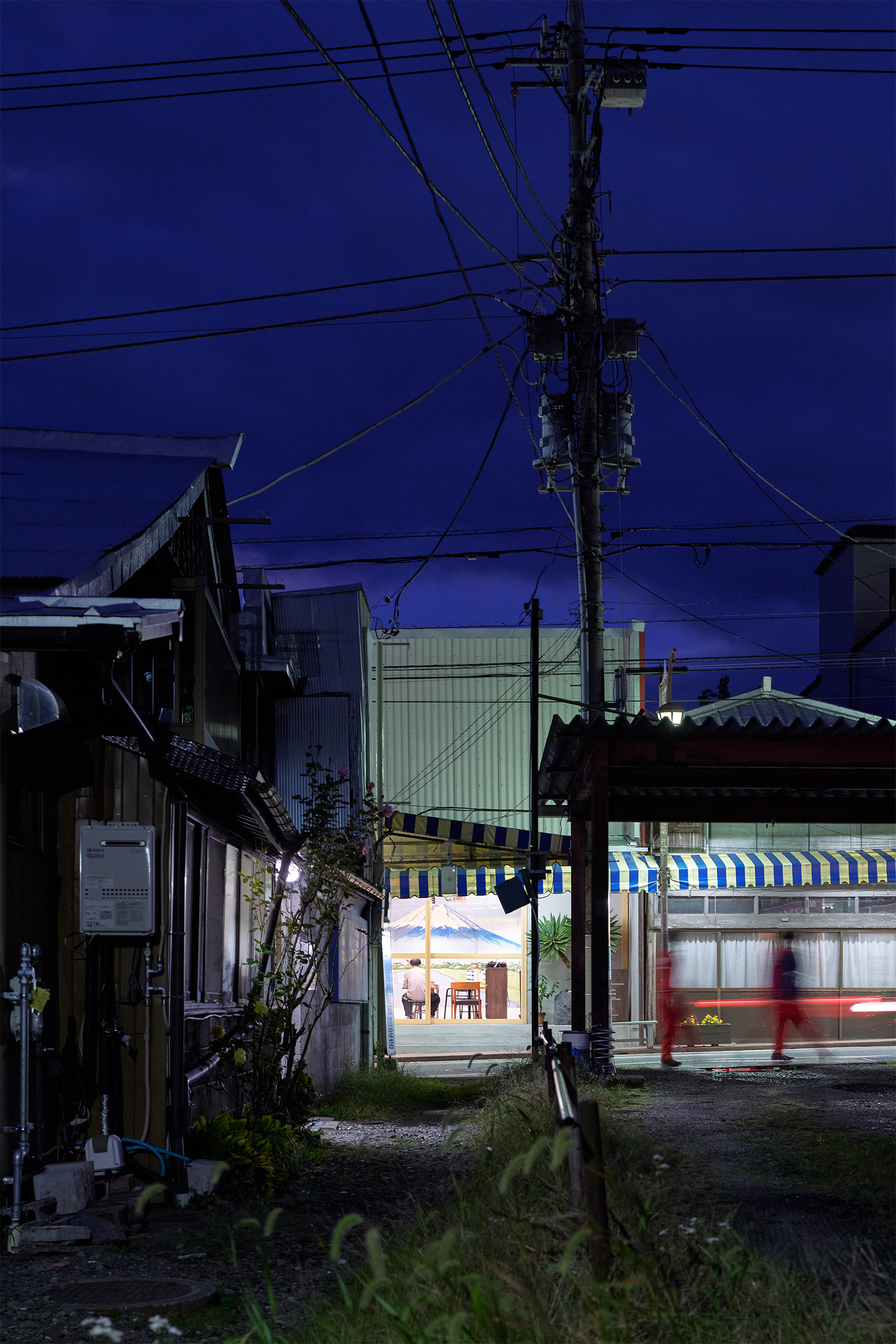プロジェクト概要
喫茶檸檬は富士吉田市の、「富士吉田市本町通り活性化プロジェクト」としてつくられた。
富士山に日本一近いと言われる山梨県富士吉田市。市内の至るところから大迫力の富士山を望むことができ、中でも「富士山がきれいに見える商店街」として、富士吉田市本町通りはメディアからも注目されてる。1000年以上続く繊維のまちとしても知られファッションブランドの産地として活気溢れるまちとして発展した。しかし、昭和50年代に入ると経済はグローバル化し、低廉な製品が国内に流通し衰退。通り自体は閑散とし空き家や空き店舗が増え、シャッター商店街と化しているのが現状だ。
本プロジェクトは、この本町通りを起点に地域の伝統産業を活用した事業と、地産地消を目指し地元の農作物を使用した運営を行い、空き家や空き店舗を活用し、内装のリノベーション、コンテンツ制作、PR力のあるクリエイターを誘致した長期運営を行い地域の更なる活性化を目的としたプロジェクトである。本プロジェクトを、地域の空き家等活用のモデルケースとしてPRすることで、新たな出店や移住、2拠点居住、ワーケーションの場所として、内外からのニーズや投資を増やしていくことで更なる地域の活性化を目指している。
設計コンセプト
同店を運営・プロデュースする、東京のデザイン事務所(株)れもんらいふは、富士吉田の資源と東京のクリエイティブが混り合う場所にしたいという思いがあった。そこで我々は、ここに来る多様な人々の活動が街の日常の風景の一部として切り取られたり、またある時には映画のワンシーンのような非日常の瞬間として映えるように、2つの舞台を設えることにした。
1つ目は、前面道路の本町通りに対する舞台である。基礎補強を兼ねた新たな床面は、通りより400mm程度高く設定している。そこに、左右対称、幅7,280mm、高さ2,400mmの大きな開口部を設けることで、通りに対して舞台ステージのようなフレームをつくりあげた。日々、店内で繰り広げられる様々な風景が、映画のワンシーンの様にこの通りに映し出されていく。
このステージはその他にも機能的に重要な役割を果たしている。ひとつは通りと店内の間に断面的な距離をうみだすことである。本町通りは道幅の割に交通量が多く、大型車両なども多く行き交う通りである。道路面より店内を少し高く設定することで、断面的な距離をつくり、店内に居る人が落ち着いて過ごせる環境を整えることを目指した。
そして、もうひとつは、街を行き交う人々のストリートファニチャーとして機能する事である。軒下の段差の一部は、ちょうど椅子くらいの高さになっており、近所を散歩している地元民や、観光客が気軽に足を休める場所になることを期待している。
2つ目の舞台装置は、店内の半分の面積を占めるオープンキッチンとハイカウンターである。中で行われている作業工程がどこからもでも見渡すことができ、客とシェフの出会いを高めた構成とした。天井に用いた中空ポリカーボネート板は、光が反射するレフ板のような働きをしてキッチンとその活動を引き立てる。客とシェフの出会いや活動が引き立つように、ハイカウンター素材や形状はシンプルに留めた。
舞台のような同店でシェフ、スタッフ、客が活気を生み出し、通りや街に賑わいが増える未来に期待したい。
中川 宏文 (O.F.D.A) + 山本 稜 (Spicy Architects)
Project Overview
Teahouse Lemon is one of the Fujiyoshida City Honcho-dori Avenue Revitalization Projects.
Fujiyoshida City is located in Yamanashi Prefecture and known as the closest city to Mt. Fuji. The imposing mountain can be seen from everywhere and Honcho-dori Avenue, in particular, is the focus of media attention as a shopping street where Mt. Fuji can be looked up from a perfect angle. The city also had been known as the center of textile industry for more than 1,000 years and enjoyed booming fashion industry and vibrant streets until the 1970s. Then, it started to decline with the development of global competition and the proliferation of cheap products all over Japan. Today, the once-thriving shopping street is almost deserted and dotted with closed shops and vacant houses that have pulled down their storefront shutters.
The aim of the project is to bring back a dynamic community, starting from the Honcho-dori Avenue. In a long term, new businesses will be developed by taking advantage of the traditional local industry and promoting local food, vacant houses and shops will be refurbished, and attractive contents will be produced and disseminated by communication-savvy creative people who are invited here. Most importantly, if the project is publicized as a successful model case of reutilization of a vacant house in a local community, it will encourage and inspire new activities such as new store openings, relocation from urban areas, dual-location living, and ‘workation (work + vacation)’. Eventually, it will generate additional investments and extra demand inside and outside the community that push the revitalization further.
Design Concept
The project was developed by a Tokyo-based design office Lemon Life that also runs the place. In their original idea, they wanted to create a space where local leaders who are committed to the future of Fujiyoshida City and Tokyo’s creative talent can mingle. In response to their request, we decided to add two stage-like structures. Various activities performed around these stages by creative people from different backgrounds can be watched as snippets of everyday life. Sometimes, the same scenes can be projected as an extraordinary moment in life seen in a movie.
The first structure is set in front of the teahouse facing Honcho-dori Avenue. In order to reinforce the house’s foundation, the floor is elevated approximately 400mm from the street. Then we put a symmetrical frame structure, 7,280mm in width and 2,400mm in height, on the elevated floor to make it look like a performing stage. Everyday activities happening inside the teahouse is shown to passers-by on the street like a movie.
This stage has other important functions. One is to secure a comfortable cross-sectional distance between the teahouse and the street. Honcho-dori Avenue is relatively narrow but it’s busy with the traffic of cars and large trucks. The elevated front area creates a cross-sectional distance from the busy street so that visitors inside can feel safer and more relaxed.
Another is a function as street furniture. The height of the stage under the eaves of the shop is about the height of a chair. It is a good place for local people and tourists who are strolling the area to sit down to have a rest.
The second structure is a set of open kitchen that occupies a half of the floor area and a raised counter. It is designed to allow the guests to watch what’s happening inside the kitchen from every corner of the shop. This helps create intimacy between them and a chef.Polycarbonate boards hung from a ceiling function like a reflector, distributing light all around the shop and supplying energy to the people in the kitchen.The material and the shape of the counter is plain to make the interaction between the chef and guests stand out.
I hope these structures will bring out energies from the chef, staff and guests and the vibrant teahouse will bring back liveliness on the street and to the area in the future.
Hirofumi Nakagawa (O.F.D.A.) + Ryo Yamamoto (Spicy Architects)
